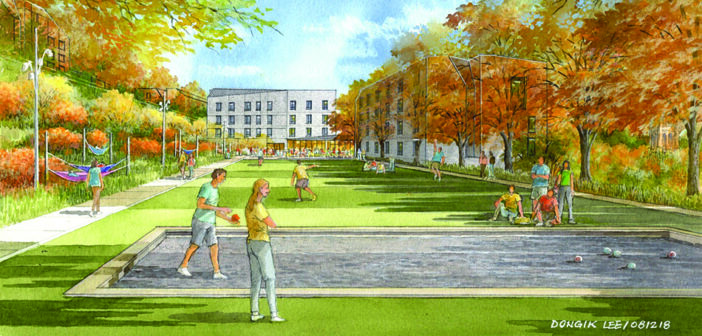Slowed by the pandemic, Lehigh’s second phase of the Path to Prominence initiative has no clear timeline for when it will begin or be completed.
A primary goal of the Path to Prominence plan is to expand the school’s student body. Much of this plan involves creating new housing for future students and replacing the dorms in Trembley Park, which were set to be demolished last year. The demolition of Trembley was put on hold following backlash from the student body.
In the past, Trembley housed approximately 200 upperclassmen. This year it serves as isolation housing for students with suspected or confirmed COVID-19 cases on campus.
Brent Stringfellow, associate vice president of Facilities and university architect, said the first possible completion date for construction could be summer of 2022. Stringfellow said he is still unsure of this timeline and is cautious to make any definite predictions.
“We were still, even prior to the start of the pandemic, trying to figure out when the logical time to start construction would be. The pandemic has thrown a fair amount of disarray into the future planning,” Stringfellow said.
Stringfellow said Trembley has been a valuable resource this year.
He said not knowing how the pandemic will affect student-life over the next several months makes taking action on Trembley more difficult.
“We are reticent to commit to taking down Trembley any time soon,” Stringellow said. “Again, we have seen its value during the pandemic, and while we are all cautiously optimistic that the fall will not need that, at least to the degree we do now, I think everybody’s still a little gun shy.”
Pat Johnson, Lehigh’s vice president for Finance and Administration, shared Stringfellow’s uncertainty and spoke to the financial aspects of the project. Johnson said the dorms built during phase two will be smaller than the Singleton, Hitch, and Maida houses of phase one.
The current budget for phase two is $61 million, however, it has not yet been approved and was developed primarily for planning purposes, Stringfellow said.
“We get gifts, which is why we have the names of the houses in phase one. Between that and debt, we generally operate like that. That’s how we funded phase one, so we are thinking the same thing for phase two,” Johnson said. “We expect to get a similar amount of gifts to phase two but the other part is market-driven which involves if we have to borrow, how much we have to borrow depending on construction cost and the cost of interest rates at that time.”
Stringfellow said he hopes the project will foster unity between the residential and academic areas of campus, which he said are structurally separated.
He said the projects of the Path to Prominence initiative aim to reduce that separation.
“Right now there tends to be a very strong dividing line,” Stringfellow said. “The existing UC doesn’t help that. The UC almost acts like a wall at this point so trying to open that up and create a kind of extension of spaces and activities that will help to knit the campus together more effectively.”
Stringfellow said he hopes to provide students with more service spaces on campus such as study rooms, fitness studios, eating areas and multipurpose rooms. These amenities will be open to all Lehigh students, not just the residents of the dorms.






Comment policy
Comments posted to The Brown and White website are reviewed by a moderator before being approved. Incendiary speech or harassing language, including comments targeted at individuals, may be deemed unacceptable and not published. Spam and other soliciting will also be declined.
The Brown and White also reserves the right to not publish entirely anonymous comments.
1 Comment
I don’t understand why the administrators necessarily want to “foster unity between the residential and academic areas of the campus”, which Mr. Stringfellow notes are structurally separated. I would agree that a delineation does exist and with University Drive (viz. the road in back of Johnson Hall) being the line. Yet one might say separation is a good thing. In our homes, are not the bedrooms typically removed, or on the second or third floors, from the common areas?
To have some intermingling of the residential and academic might be fun and exciting, and we have that now with the apartments off Brodhead Ave., besides of course Trembley itself. ‘Walls’ and separation can be a logical, and even in some ways a beautiful, feature if properly conceived and executed.